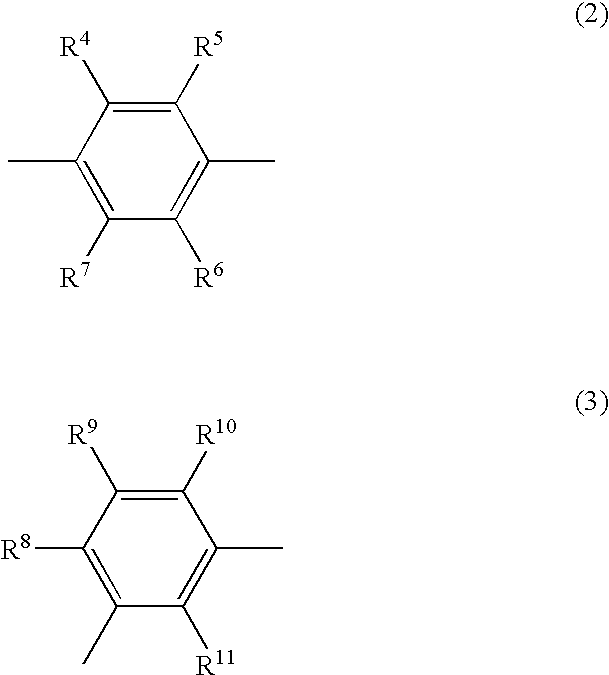Charge-transporting varnish
a technology of charge-transporting varnish and varnish, which is applied in the direction of transportation and packaging, electrically-conductive paints, non-metal conductors, etc., can solve the problems of poor dispersibility, achieve adequate viscosity, reduce drive voltage, and improve luminous efficiency
- Summary
- Abstract
- Description
- Claims
- Application Information
AI Technical Summary
Benefits of technology
Problems solved by technology
Method used
Image
Examples
example 1
[0103]Phenyltetraaniline (PTA) was prepared as follows according to the process mentioned in Bulletin of Chemical Society of Japan, 1994, vol. 67, pp. 1749-1752.
[0104]In 2 liters of toluene was dissolved 12.977 g of p-phenylenediamine. The resulting solution was given 245.05 g of tetra-n-butoxytitanium (as a dehydration-condensation agent), which was dissolved at 70° C. for 30 minutes. With 53.346 of p-hydroxydiphenylamine added, reaction was carried out at 100° C. for 24 hours under a nitrogen stream. After reaction was complete, the reaction mixture was filtered and remaining solids were washed sequentially with toluene and ether. After drying, slivery crystals were obtained. One part by weight of the crystals was placed in 25 parts by weight of dioxane together with 0.2 equivalent of hydrazine hydrate. With the atmosphere in the reaction system replaced with nitrogen, the crystals were dissolved by refluxing.
[0105]To the resulting solution was added toluene (in an amount of 25 pa...
example 2
[0120]Four kinds of varnishes were prepared as follows from PTA (which had been synthesized and purified by the process mentioned in Example 1) and 5-SSA in the same way as in Example 1 (with their molar ratio remaining unchanged at 1:4 and the solids content remaining unchanged at 4.2 wt %), except that the solvent composition and ratio were changed.
[0121]That is, PTA and 5-SSA were dissolved in DMAc under a nitrogen atmosphere. The resulting solution was incorporated with c-HexOH, or dipropyleneglycol (DPG for short hereinafter), or DPG plus BC (as the high-viscosity solvent). All of the resulting varnishes were complete solutions free of solids precipitation.
[0122]Table 1 shows the appearance, viscosity, and film-forming conditions of the varnish. It is noted from Table 1 that the viscosity of the varnish ranges from 1.4 to 58 mPa·s depending on the solvent composition and mixing ratio.
[0123]The thus obtained varnishes were used to prepare OLED elements in the same way as in Exam...
example 3
[0124]One of the varnishes in Example 2, which was dissolved in a mixed solvent of DPG-DMAc-BC (6:3:1), was formed into a thin film by off-set printing method under the condition shown in Table 1. An OLED element with this thin film was prepared. Table 3 shows the characteristic properties of the resulting OLED.
PUM
| Property | Measurement | Unit |
|---|---|---|
| boiling point | aaaaa | aaaaa |
| boiling point | aaaaa | aaaaa |
| viscosity | aaaaa | aaaaa |
Abstract
Description
Claims
Application Information
 Login to View More
Login to View More - R&D
- Intellectual Property
- Life Sciences
- Materials
- Tech Scout
- Unparalleled Data Quality
- Higher Quality Content
- 60% Fewer Hallucinations
Browse by: Latest US Patents, China's latest patents, Technical Efficacy Thesaurus, Application Domain, Technology Topic, Popular Technical Reports.
© 2025 PatSnap. All rights reserved.Legal|Privacy policy|Modern Slavery Act Transparency Statement|Sitemap|About US| Contact US: help@patsnap.com



